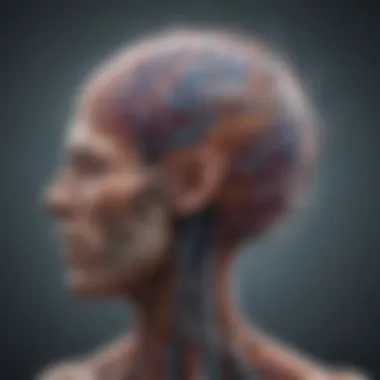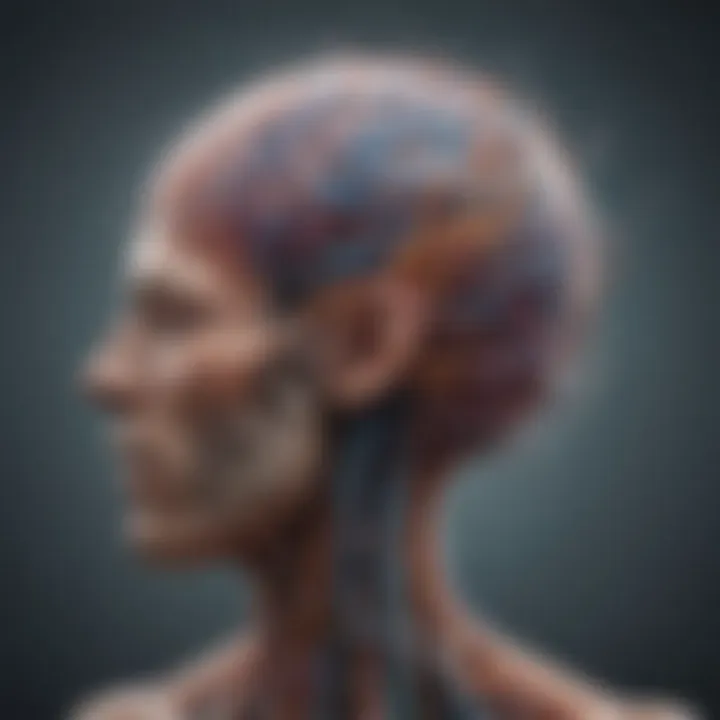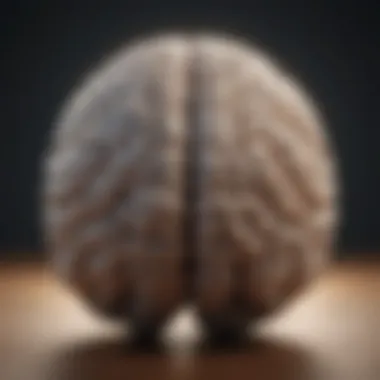The Impact of Anxiety on Brain Functioning


Intro
Anxiety is a common emotional response characterized by feelings of tension, worry, and nervousness. Its effects extend beyond subjective experiences, influencing various biological systems, particularly brain functioning. Understanding how anxiety impacts the brain is crucial, given its prevalence in society and its effects on mental health. Throughout this article, we will delve into the neurobiological aspects of anxiety, looking at cognitive processes and emotional regulation, alongside the implications for overall mental well-being.
Research Highlights
Overview of Key Findings
Research into anxiety reveals several key findings about its impact on brain functioning. Studies indicate that anxiety can lead to alterations in neural connectivity, cognitive impairment, and emotional dysregulation. These changes may result in long-term consequences that affect individuals' daily lives.
- Cognitive Processes: Anxiety has been shown to impair working memory and attention. Individuals with high anxiety levels often experience difficulty concentrating and making decisions.
- Emotional Regulation: Anxiety disrupts emotional regulation, making it challenging for individuals to manage their emotions effectively. This can lead to heightened emotional responses or feelings of overwhelm.
- Neural Connectivity: Functional imaging studies often show reduced connectivity in regions like the prefrontal cortex, which is critical for decision-making and emotional control.
Significance of the Research
Understanding the relationship between anxiety and brain function is significant for multiple reasons. First, it informs clinicians and researchers about the biological aspects of anxiety disorders, leading to better treatment approaches. Second, it enhances awareness of mental health challenges in society, paving the way for stigma reduction and improved support systems. Lastly, comprehensive knowledge of neurobiological impacts can empower individuals to seek help and understand their experiences better.
Original Research Articles
Summary of the Article
Several original research articles contributing to this discourse have emerged. These include investigations measuring cognitive performance among anxious individuals and how anxiety-related brain activity can differ from non-anxious control groups. The collective evidence offers insights into how anxiety manifests cognitively and emotionally, affecting overall brain health.
Author Contributions
Various researchers have made significant contributions to this field. Notable figures include Dr. Elizabeth Phelps and Dr. David G. Myers, whose work has helped illuminate the connections between anxiety, neural circuitry, and cognitive functions. Their studies utilize advanced imaging techniques to portray the intricate ways anxiety reshapes brain activities.
Prelims
Anxiety is more than just a transient feeling of unease; it is a complex mental health condition with profound implications for individuals’ functioning and well-being. Understanding anxiety’s impact on brain functioning is crucial for multiple reasons. First, anxiety disorders affect a significant portion of the population. According to the Anxiety and Depression Association of America, around 40 million adults in the United States are affected by anxiety disorders. This highlights the need for effective strategies to manage these conditions.
Given the widespread nature of anxiety, it is essential to recognize its multifaceted effects on cognitive processes. Anxiety alters the way we think, focus, and even remember. For students, researchers, and professionals, these changes can hinder academic performance and workplace efficiency. Knowing how anxiety influences attention, memory, and decision-making enables individuals to modify their approaches in both learning environments and professional settings.
Moreover, good understanding of anxiety’s impact on emotional regulation is vital. Anxiety can distort emotional responses, leading individuals to feel overwhelmed or detached. This is particularly relevant in high-stress environments where emotional intelligence plays a key role in performance, such as workplaces or academic institutions.
In the discussions that follow, we will explore the neurobiological mechanisms underpinning anxiety, the cognitive effects it brings, and the emotional dynamics involved. We will consider aspects such as structural brain changes and neuroplasticity. These deeper insights are not just academic; they have real-world implications on therapeutic approaches. By examining and synthesizing current research findings, this article aims to inform better mental health strategies and deepen understanding of anxiety’s roles in human behavior and mental health struggles.
Understanding the dynamics of anxiety is essential for developing effective interventions and improving quality of life for those affected.
Understanding Anxiety
Understanding anxiety is crucial for comprehending its broader impact on brain functioning and overall mental health. This section connects the dots between the physiological aspects of anxiety and how they manifest in cognitive and emotional domains. Anxiety disorders encompass a range of conditions that affect millions of people worldwide, making the importance of this topic evident.
In exploring anxiety, we look at how it influences brain activity, contributes to stress response, and alters individual behavior. In a way, understanding anxiety illuminates pathways for effectively managing its effects, leading to improved psychological outcomes. This lays the groundwork for subsequent sections, where we will analyze the neurobiological mechanisms, cognitive effects, and therapeutic approaches to treating anxiety.
Defining Anxiety Disorders
Anxiety disorders are characterized by excessive fear and apprehension, often disrupting everyday life. These disorders are not mere temporary feelings of worry; they encompass persistent, intrusive thoughts and behaviors that hinder functioning. Recognizing this distinction is essential, as it allows for better understanding and approaches to treatment.
Formal diagnostic criteria are outlined in the Diagnostic and Statistical Manual of Mental Disorders (DSM-5), categorizing anxiety disorders into specific types, each with its uniqueness and challenges. Through diagnostics, we can address the root causes and tailor treatments accordingly.
Common Types of Anxiety
Different categories of anxiety disorders demonstrate how diverse the phenomena can be. Below, we highlight four common types, discussing their significance and hallmark features.
Generalized Anxiety Disorder
Generalized Anxiety Disorder (GAD) is marked by chronic, exaggerated worrying about daily life events. Individuals with GAD often feel overwhelmed, unable to control their anxieties. This disorder is significant in the article because it showcases how anxiety can lead to increased cognitive load and decreased overall brain function.
Key characteristics include persistent tension and frustration, contributing to impaired memory and decision-making. A unique feature of GAD is the pervasive sense of fear that may not always be tied to specific events, making it a stealthy challenge to address. This characteristic highlights both the advantages, in terms of recognizing hte need for management, and disadvantages, as it complicates tailored treatments.
Social Anxiety Disorder
Social Anxiety Disorder is characterized by intense fear of social situations or interactions. This specific type causes individuals to worry excessively about being judged or embarrassed in social scenarios. Its contribution to the overall understanding of anxiety lies in how social interactions and perceived threats can heavily influence one's mental state.
A key trait is the profound fear of scrutiny, which can lead to avoidance behaviors that severely limit opportunities for personal and professional growth. The unique aspects of this disorder underscore the challenges many face in navigating social contexts, making it indispensable to the discussion of anxiety.
Post-Traumatic Stress Disorder
Post-Traumatic Stress Disorder (PTSD) arises following exposure to traumatic events. This disorder underscores the importance of context and experience in shaping anxiety responses. Its relevance in the article is clear: it emphasizes how traumatic events can disrupt neural pathways and emotional regulations.
Individuals with PTSD often deal with flashbacks, avoidance, and hyperarousal, making it distinct from other anxiety disorders. Dealing with this disorder has both advantages in revealing how strong experiences shape anxiety but also disadvantages as it complicates treatment strategies due to the nuanced nature of trauma.
Obsessive-Compulsive Disorder


Obsessive-Compulsive Disorder (OCD) involves the presence of obsessions—intrusive thoughts—and compulsions—repetitive behaviors performed to alleviate anxiety. This disorder enriches the overall narrative on anxiety, which highlights how mental processes can influence behavior as individuals seek to manage their fears.
Key characteristics of OCD include the need for control and the often irrational nature of compulsions, leading to distress and disruption in daily lives. The unique aspect of OCD lies in its cyclical nature, wherein obsessive thoughts lead to compulsive actions, which reinforces anxieties. This trait is essential when discussing the challenges faced in therapeutic approaches for anxiety management.
All these types of disorders paint a vivid picture of a complex issue—anxiety. Understanding these distinctions sets the scene for further examination of how anxiety impacts brain functioning on multiple levels.
Neurobiological Mechanisms
The examination of neurobiological mechanisms is crucial for understanding how anxiety affects brain functioning. It involves various elements such as brain structure, biochemical pathways, and their interactions. This section will zoom in on two significant aspects: the specific brain regions involved in anxiety and the key neurotransmitter systems that mediate these responses. Understanding these details is vital for identifying how anxiety manifests in the brain, and how this knowledge can aid in the development of targeted therapies.
Brain Regions Involved in Anxiety
Amygdala
The amygdala is a small, almond-shaped cluster of nuclei located deep within the temporal lobes of the brain. Its primary role is related to processing emotions and is especially associated with fear and pleasure responses. In terms of anxiety, the amygdala's heightened activity can lead to exaggerated fear responses. This makes it a central topic in anxiety research. Its reactivity is often linked to the severity of anxiety symptoms.
One unique feature of the amygdala is its proximity to emotional processing centers in the brain, allowing it to quickly respond to perceived threats. However, its overactivity can lead to negative consequences, such as heightened anxiety and panic disorders. Understanding the amygdala's role could reveal therapeutic avenues for those suffering from anxiety.
Prefrontal Cortex
The prefrontal cortex, located in the frontal lobe, plays a critical role in decision-making, planning, and moderating social behavior. It also holds an important place in anxiety’s cognitive aspects. This region helps in regulating emotional responses initiated by the amygdala, hence acting as a balancing force. When anxiety is present, the prefrontal cortex may become less effective, resulting in poor decision-making and impulsive behaviors.
A distinguishing characteristic of the prefrontal cortex is its capacity for higher-order thinking, which can become compromised during anxiety episodes. Its diminished efficiency could help in understanding the cognitive dysfunctions often associated with anxiety disorders. On the downside, therapies targeting this area must consider how to enhance its function without overstimulating the amygdala, which can create a complex therapeutic challenge.
Hippocampus
The hippocampus is another critical brain structure involved in anxiety, known primarily for its role in memory formation. In anxiety disorders, the hippocampus can undergo structural changes, potentially impacting memory and learning negatively. Research shows that chronic stress can lead to hippocampal atrophy, further complicating anxiety-related issues.
The hippocampus is unique due to its involvement in forming new memories and processing contextual information. This makes it particularly relevant for understanding how anxiety might impair memory function and perception of safety. While interventions can enhance hippocampal function, there is also concern about the long-term implications of sustained anxiety on this region's structural integrity.
Neurotransmitter Systems
GABA
GABA, or gamma-aminobutyric acid, is the primary inhibitory neurotransmitter in the brain. Its function is to reduce neuronal excitability throughout the nervous system. In the context of anxiety, GABA operates as a crucial calming agent, helping to regulate the excessive activity often seen in anxious states.
The key characteristic of GABA is its ability to produce a relaxing effect on the brain. This quality makes it an essential focus in anxiety research, as many anti-anxiety medications work by enhancing GABAergic activity. However, a reliance on GABA-based therapies may carry the risk of tolerance and dependency.
Serotonin
Serotonin is another vital neurotransmitter linked to mood regulation, and it plays a significant role in anxiety as well. Low levels of serotonin are often observed in individuals with anxiety disorders. Its impact on mood indicates why many selective serotonin reuptake inhibitors (SSRIs) are commonly prescribed to manage anxiety symptoms.
One notable feature of serotonin is its wide-reaching influence on various brain functions, including mood, sleep, and appetite. While effective for many, treatments targeting serotonin must be tailored to avoid unwanted side effects, emphasizing the need for careful monitoring during treatment.
Dopamine
Dopamine is known for its role in the brain's reward pathway, influencing motivation and pleasure. It also has implications in anxiety, particularly concerning behaviors associated with avoidance and pleasure. Research indicates that alterations in dopamine levels can exacerbate anxiety symptoms.
The key aspect of dopamine is its link to reward assessment, making its function highly relevant for understanding anxiety responses in social situations. A critical challenge associated with dopamine-related anxiety treatments stems from balancing improved dopamine activity without triggering addictive behaviors or increasing anxiety.
Understanding these neurotransmitter systems is vital to offer a clearer picture of how they interact with various brain regions involved in anxiety.
Cognitive Effects of Anxiety
Understanding how anxiety impacts cognition is essential. Cognitive functioning encompasses various mental processes, including perception, attention, memory, and decision making. For individuals dealing with anxiety, these processes can be significantly affected. Anxiety has been shown to impair cognitive functions in both subtle and pronounced ways.
It is important to recognize that cognitive effects of anxiety are not merely transient; research has indicated a pattern of cognitive deficits associated with chronic anxiety. These deficits might contribute to broader mental health issues and affect daily life.
These cognitive impairments are often intertwined with emotional regulation, as anxiety can alter one's ability to process information and make decisions. Therefore, comprehending the cognitive effects of anxiety can shed light on its overall impact on mental health and well-being.
Impact on Attention and Focus
Anxiety typically compromises the capacity for attention and focus. When an individual is anxious, their mind often shifts toward perceived threats or stresses rather than the task at hand. This shift can lead to difficulties in concentration.
The amygdala, part of the brain that processes fear, can become hyperactive during anxiety. This heightened state affects the prefrontal cortex's ability to maintain focus.
Some studies indicate that people with anxiety disorders may experience selective attention disturbances, resulting in a tendency to focus on negative stimuli. This can exacerbate feelings of distress and lead to a cycle of further anxiety, impacting overall performance in work or studies.
"Anxiety creates a lens that distorts perception and invades thought processes, often emphasizing worry over productivity."
Memory Function and Anxiety
Anxiety can also significantly affect memory function. Individuals with anxiety may struggle with both working memory and long-term memory retrieval. Worrying thoughts can interfere with the brain's ability to encode new information, leading to gaps in memory formation.


Research suggests that anxiety affects the hippocampus, a critical area for memory processing, potentially leading to a reduction in hippocampal volume. This physiological aspect of anxiety can impact the ability to recall information and remember past experiences, which is detrimental for learning and personal development.
Anxiety can create a barrier to effective memory utilization. It leads to experiences where individuals repeatedly forget essential information or struggle to remember details in high-pressure situations.
Decision-Making Implications
Anxiety's effects extend into decision-making capabilities. High levels of anxiety can lead to indecision or choices driven more by fear than rational assessment. Individuals with anxiety may overthink decisions, considering worst-case scenarios rather than focusing on potential positive outcomes. This can lead to avoidance behaviors, where making a decision feels overwhelming, thus resulting in missed opportunities.
The prefrontal cortex, involved in executive functions like decision making, is particularly vulnerable to the influence of anxiety. When anxiety is at elevated levels, the ability to weigh risks and benefits objectively can be compromised, leading to poor decision-making outcomes.
Emotional Regulation
Emotional regulation plays a crucial role in how individuals manage and respond to their emotions. It is especially significant in the context of anxiety. Anxiety can disrupt normal emotional regulation processes, leading to challenges in dealing with emotions effectively. This aspect of resilience is vital for maintaining mental well-being and overall life satisfaction.
Effective emotional regulation involves recognizing one’s emotions, assessing their intensity, and responding in a way that is proportionate and constructive. Individuals who struggle with anxiety may find themselves overwhelmed by their feelings, leading to heightened stress and impaired decision-making.
Key benefits of emotional regulation include:
- Enhanced Coping Strategies: Individuals with strong emotional regulation skills can better navigate stressful situations, reducing the likelihood of panic or distress.
- Improved Relationships: Proper emotional management fosters healthier interactions with friends, family, and colleagues.
- Mental Health Stability: Effective regulation can decrease the severity of anxiety symptoms and enhance emotional resilience, promoting a greater sense of stability.
Given the profound impact anxiety can have on emotional regulation, it is essential to explore specific areas where anxiety affects emotional processing and mood disorders.
Effects on Emotional Processing
Emotional processing refers to the ability to experience, interpret, and respond to emotions. Individuals with anxiety disorders often experience distorted emotional processing. This distortion can manifest in various ways, such as heightened sensitivity to negative stimuli or difficulties in recognizing and processing positive emotions. For instance, someone with generalized anxiety disorder might find it hard to appreciate enjoyable experiences due to a pervasive sense of dread.
Research indicates that anxiety can lead to:
- Hypervigilance to Threats: Individuals may become excessively aware of potential dangers or negative outcomes, hindering their ability to enjoy the present moment.
- Avoidance of Emotions: They might avoid feeling particular emotions altogether, which can lead to further entrenchment of anxiety and emotional numbness over time.
- Cognitive Biases: Anxious individuals often develop cognitive biases that skew their emotional evaluations, making them see neutral situations as threatening.
Understanding these factors is crucial in addressing the emotional ramifications of anxiety. By recognizing the patterns in emotional processing, individuals can work toward improving their emotional regulation skills.
Anxiety and Its Influence on Mood Disorders
Anxiety not only affects emotional processing but also significantly influences mood disorders. The interplay between anxiety and mood disorders can create a cycle where each condition exacerbates the other. Conditions like depression often coexist with various anxiety disorders, complicating treatment and recovery.
Notable influences of anxiety on mood disorders include:
- Increased Severity of Symptoms: Anxiety can worsen the overall affective state of individuals with mood disorders, leading to more intense depressive episodes.
- Difficulties in Treatment: Co-existing anxiety symptoms may complicate therapeutic approaches, often requiring a more tailored treatment plan.
- Impaired Quality of Life: Individuals struggling with both anxiety and mood disorders may experience a significant decrease in their overall quality of life, impacting their ability to function daily.
"Understanding the complex relationship between anxiety and mood disorders is essential for effective treatment and management strategies."
Long-Term Effects of Anxiety on Brain Structure
The long-term effects of anxiety on brain structure are critical for understanding how chronic anxiety can reshape mental health. Over time, sustained anxiety can lead to structural alterations in the brain that impact functionality and overall cognitive performance. This section explores these significant changes and their implications.
Neuroplasticity in Anxiety Disorders
Neuroplasticity refers to the brain's ability to reorganize itself by forming new neural connections. In the context of anxiety disorders, this is particularly essential. Persistent anxiety can alter the brain's neuroplastic properties, making the brain more prone to maladaptive changes. This means that instead of forming connections that might help cope with anxiety, the brain may instead reinforce negative thoughts and fears.
Research suggests that chronic anxiety might lead to ineffective neural pathways becoming dominant. This interference can diminish cognitive flexibility and responsiveness. Individuals with anxiety might find that their brain structures related to coping and emotional regulation become less efficient over time. This has significant implications for therapeutic approaches targeting anxiety and suggests that early intervention could help mitigate such long-term effects.
Structural Brain Changes
Cortical Thinning
Cortical thinning refers to a reduction in the thickness of the outer layer of the brain, the cortex. This phenomenon is often observed in individuals suffering from long-term anxiety. Cortical thinning may contribute to a decline in certain cognitive functions, including attention and problem-solving abilities.
The key characteristic of cortical thinning is that it affects specific areas of the brain involved in emotional regulation and cognitive control. This is a significant concern as it suggests that prolonged anxiety not only affects mood but also impacts the capacity for rational thinking and emotional stability. As a result, individuals may find it harder to function in everyday life.
The unique feature of cortical thinning is its reversible nature with appropriate interventions. Understanding this ensures that the focus remains on treatment modalities that can help rebuild cortical thickness through lifestyle changes and therapeutic techniques.
"Chronic anxiety can lead to structural brain changes that might exacerbate the condition, illustrating the complex interplay between mental health and neuroanatomy."
Hippocampal Volume Reduction
The hippocampus is a crucial brain region associated with memory formation and emotional response. Hippocampal volume reduction can occur due to chronic anxiety, affecting both memory and the processing of emotional events. It is considered a common finding in studies related to anxiety disorders.
The key characteristic of hippocampal volume reduction is its direct association with memory impairments and difficulties in learning. This aspect is essential for understanding how anxiety can influence academic performance and daily decision-making. The more the volume decreases, the more pronounced these effects may become.
One unique feature of hippocampal volume reduction is its strong link to experiences of trauma and stress. When anxiety becomes chronic, it can lead to persistent alterations in this area of the brain. On the one hand, this insight can indicate the necessity for targeted therapies. However, the disadvantages include a potentially irreversible impact on long-term memory capabilities if therapeutic interventions are delayed or inadequate.
Stress Response Systems
Understanding stress response systems is essential in the context of how anxiety impacts brain functioning. The body's ability to respond to perceived threats is fascinating and multilayered. When anxiety manifests, it often highlights these systems, especially the Hypothalamic-Pituitary-Adrenal axis. The HPA axis plays a crucial role in regulating stress hormones such as cortisol, which in turn influences mood, focus, and overall cognitive functions.
In chronic anxiety scenarios, the HPA axis may become dysregulated. This means that stress responses can become exaggerated, leading to a state where the brain is constantly on high alert. The implications of this include heightened sensitivity to stressors, diminished cognitive function, and alterations in emotional regulation. Understanding these mechanisms helps in grasping how anxiety can affect mental health over time.


Hypothalamic-Pituitary-Adrenal Axis
The HPA axis consists of three main components: the hypothalamus, the pituitary gland, and the adrenal glands. When an individual experiences stress, the hypothalamus releases corticotropin-releasing hormone (CRH). This hormone signals the pituitary gland to secrete adrenocorticotropic hormone (ACTH), which then prompts the adrenal glands to produce cortisol. Elevated cortisol levels help the body to manage stress and promote alertness.
However, while this process is vital for immediate stress responses, prolonged exposure to high stress can cause a variety of issues. Over time, excessive cortisol can lead to cognitive issues, including problems with memory and decision-making.
Key points about the HPA axis include:
- Regulation of stress hormones: Affects overall stress responses.
- Influence on anxiety disorders: Dysregulation may exacerbate symptoms.
- Relevance to health: Long-term changes can contribute to various mental health conditions.
Chronic Stress and Anxiety Disorders
Chronic stress closely relates to anxiety disorders and is an area of increasing interest in research. When an individual is exposed to stress over an extended time, the continual activation of the HPA axis can lead to structural and functional changes in the brain.
Impacts of chronic stress include:
- Reduction in hippocampal volume: This area is crucial for memory and learning.
- Emotional dysregulation: Long-term anxiety can lead to persistent mood disorders.
- Impaired cognitive function: Difficulty with focus and decision-making can arise.
Anxiety is more than a temporary concern; it can create a cycle of chronic stress that further complicates management and treatment. Addressing these systems through therapeutic approaches is essential in alleviating symptoms of anxiety and improving brain health. Understanding the interplay between chronic stress and anxiety provides valuable insights for researchers and healthcare professionals in the field.
Therapeutic Approaches
Therapeutic approaches are crucial in addressing anxiety and its impact on brain functioning. Understanding these methods can lead to improved mental health outcomes. They include psychological therapies, like Cognitive Behavioral Therapy (CBT), and pharmacological options. Combining these strategies can enhance their effectiveness and provide better coping mechanisms for individuals suffering from anxiety.
Cognitive Behavioral Therapy
Cognitive Behavioral Therapy (CBT) focuses on identifying and changing distorted thought patterns. This method helps individuals confront negative beliefs that contribute to anxiety. CBT emphasizes the connection between thoughts, feelings, and behaviors.
When engaging in CBT, patients learn to recognize triggers of their anxiety. They practice new ways of thinking which can reduce feelings of distress. This therapeutic method is structured and often short-term, leading to significant improvements in mental well-being.
Emphasizing practical skills, CBT teaches coping strategies for anxiety management. Clients often feel empowered through this process. Research shows that CBT can alter brain functioning. This therapy can strengthen connectivity in brain regions related to emotional regulation.
Pharmacological Treatments
Pharmacological treatments offer another layer of support in the management of anxiety disorders. Medications can help regulate neurotransmitters, leading to reduced anxiety symptoms.
SSRIs
Selective Serotonin Reuptake Inhibitors (SSRIs) are commonly prescribed for anxiety disorders. They work by increasing levels of serotonin in the brain, which can enhance mood and alleviate anxiety.
- Key Characteristic: SSRIs are well-regarded for their efficacy in treating anxiety and related mood disorders.
- Why Beneficial: They have a favorable safety profile compared to older medications, with fewer side effects.
- Unique Feature: Unlike benzodiazepines, SSRIs do not cause dependency and are effective over a long term.
- Advantages/Disadvantages: While SSRIs can take weeks to show effects, their long-term benefits outweigh this initial waiting period.
Beta-Blockers
Beta-Blockers, such as propranolol, target the physical symptoms of anxiety, like a racing heart. These medications block adrenaline effects, which can suppress the physical responses associated with stress.
- Key Characteristic: They are often used for situational anxiety, such as performance anxiety.
- Why Beneficial: They can provide quick relief from anxiety symptoms, especially in high-pressure situations.
- Unique Feature: Their ability to address physical symptoms directly makes them distinct from most anxiety medications.
- Advantages/Disadvantages: Beta-blockers do not address the psychological causes of anxiety, making them less effective for generalized anxiety disorders.
The combination of therapeutic strategies enhances outcomes, leading to better management of anxiety and its impact on brain functioning.
Overall, choosing an appropriate therapeutic approach is essential for individuals experiencing anxiety. Understanding the options available can empower patients and improve their quality of life.
Closure
The conclusion of this article encapsulates the intricate relationship between anxiety and brain functioning. Understanding this impact is vital for several reasons. First, it brings awareness to how anxiety can undermine cognitive processes, thereby affecting decision-making, memory, and emotional regulation.
Moreover, recognizing the physiological changes that anxiety induces can lead to better therapeutic strategies. For instance, treatments can be tailored more effectively when one understands how anxiety alters brain regions such as the amygdala and prefrontal cortex.
The significance does not stop with treatment. It extends to educational settings, workplaces, and personal life. Knowledge of how anxiety impacts behavior can foster supportive environments, reducing stigma and promoting mental health awareness.
"Awareness about the mechanisms of anxiety can facilitate more informed conversations around mental health, leading to better outcomes for patients and society."
In essence, this conclusion reminds us that anxiety is not merely a psychological hurdle but a complex condition with tangible effects on brain structure and function. Recognizing these factors can empower both individuals and professionals in addressing its challenges more comprehensively. Thus, driving research and discussion in this area is crucial for advancing our understanding and management of anxiety disorders.
Importance of References
- Credibility: Citing established sources reinforces the integrity of the findings discussed in the article. It assures the reader that the claims made are backed by empirical research, thus enhancing trust in the content.
- Informed Discussions: References allow for a deeper engagement with the subject matter. By including influential studies, articles, and other resources, the article can discuss complex topics such as neurobiological mechanisms and cognitive impacts of anxiety with greater authority.
- Further Exploration: Readers seeking to expand their understanding of anxiety's effects on brain functioning can follow these references. This can stimulate their curiosity and lead to a more comprehensive grasp of the material.
- Contextual Understanding: Including references helps to create a well-rounded view of the topic. It highlights the evolution of thought and research surrounding anxiety and its neurological implications.
Considerations for Citing References
When compiling references, several considerations should be made:
- Relevance: Ensure that each cited source is directly related to the discussion points made in the article. Irrelevant sources do not add value and can confuse the reader.
- Recency: Use more current studies to reflect the ongoing developments in the understanding of anxiety disorders and brain health, while still acknowledging foundational research.
- Diversity of Sources: Incorporating a range of sources, including peer-reviewed journals, books by experts, and reputable online resources, ensures a comprehensive perspective.
"Anxiety not only alters brain function but also modifies how we perceive and interact with the world around us."
Finale
In summary, references form the backbone of this article. They play a pivotal role in substantiating claims and enriching the narrative. By carefully selecting and citing relevant sources, the article not only informs but also invites further research into the pervasive effects of anxiety on brain functioning.







